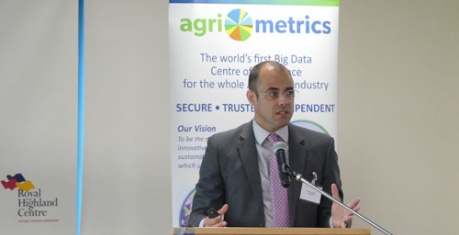Thursday 25th May 2017, 4:30pm
An innovation which allows farmers to get timely advice about potato
yield and crop values on their smartphones was just one of the
cutting-edge developments in Scottish Agri-food showcased at the recent 'Driving Innovation in Scottish Agri-food' event hosted by Scotland’s
Rural College (SRUC) and Agri-Metrics at the Royal Highland Centre at
Ingliston, Edinburgh.

The conference provided a platform for the four new Agri-Tech Centres of Innovation in Agriculture to be introduced to a Scottish audience for the first time, giving an opportunity to learn what they have to offer and how they operate.
Organisers stressed that this was an exciting time to see how the innovation landscape has grown to incorporate state of the art technology and new infrastructure to bring new capabilities in big data processing, precision engineering, livestock genetic innovation and smart crop protection.
The four centres are Agrimetrics, the Centre for Innovation Excellence in Livestock (CIEL), the Agricultural Engineering Precision Innovation Centre (Agr-EPI), and the Centre for Crop Health and Protection (CHAP). They were established to foster closer collaboration between enterprise and research.
Scotland’s Rural College is a well qualified founder partner in the first three of these centres, established as part of the UK Government’s £160 million Agricultural Technologies Strategy.
Among the real-life examples featured of how technology can help farmers in a user-friendly way was a software-based potato yield model, supported by Agrimetrics and the National Institute of Agricultural Botany (NIAB).
“Decades of science and field experience are being made available in a user-friendly way. Farmers can use their smartphones to collect information about planting date, emergence of the crops and images of canopy, to gain details of what is happening under the soil in their field.”
Professor Mario Caccamo, of Agrimetrics and NIABFor packers that have contracts with a several growers and fulfil orders from the supermarkets, estimate of yield improves forecasting and will allow alternative arrangements to be made in plenty of time if there looks to be a short fall in supply.
The event was opened by Professor Louise Heathwaite, Chief Scientific Adviser for Rural Affairs and Environment to the Scottish Government. She underlined the need to innovate to stay nimble in agri-food technology and the environment.
“This conference provided a good overview of the research ecosystem in Scotland."
“Step changing progress comes out of the sharing of ideas and this was an ideal forum for those with a commitment to innovation in the Scottish agri-food value chain to meet those working towards a new future.”
Teresa Shutter, Knowledge Exchange Manager of Agrimetrics and who is based at SRUThe event also featured a series of practical case studies from the innovation centres on Productivity in the Farms of the Future; Food Safety and Security; and Innovation in the agri-food sector. One of these featured The Satellite Applications Catapult - presenting how satellite data and other emerging technologies are being used for precision management of grassland agriculture, creating an invisible precision agriculture technology.
The event was attended by over 100 farmers, producers, processors and executives in the food sector, retailers, policy makers and intermediaries working directly with industry in Scotland.
Source: SRUC